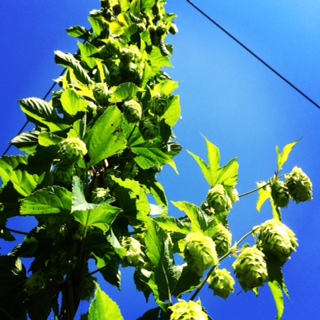 |
The team under our new trade show tent, with the new
banner and stuff. (left to right: Kenner, me, David) |
Funny how progress goes. I'm stretched for making a post here because a lot of our activities at Hawksbill Hop Yards right now are watching the bines grow - which they are, enthusiastically! - but I do have an update to report at last:
We had our first brewery visits a couple of weekends ago!
The growth of craft brewing in Virginia has been astounding. After a few years of languishing behind other states (I'm not talking about California, Colorado, or Vermont here - I'm talking about Georgia, Maryland, and North Carolina, for goodness sake (no disrespect intended)), at last Virginia is seeing a surge in breweries.
 |
| Visiting with brewers from Tin Cannon and Pen Druid. |
In 2013, the Brewers Association listed a mere 60 breweries, including the Coors establishment in Elkton and the Anheuser Busch operation in Williamsburg. A directory check at
Virginia Beer Trail now will offer over 120 breweries throughout the state, with even more scheduled to open through the rest of 2015!
At the hop yard, we hope to supply some of the new breweries, especially in the Shenandoah Valley and Northern Virginia areas - geographically close to us - with our high quality hops. So we invited a few of the new brewers out, and we were very pleased to welcome
Pen Druid Brewing from Sperryville and
Tin Cannon Brewing Company from Gainesville to the yards on a recent Sunday morning. In addition to the breweries, a couple of local VIPs joined us - our ag extension rep, Kenner, and Ligon from the Page County Economic Development Authority.
We had a good time with a brief tour of the rows and discussion of how we got this whole thing started, as well as our plans for the harvest. As we get closer to that, and solve some of our logistics challenges - nothing too difficult, in fact very typical for any start-up - we'll be reaching out to these folks and other brewers with news of what we have to offer.
That'll be great progress and we're looking forward to it! The next post will be an update on how the hops are doing, along with a preliminary harvest schedule.














